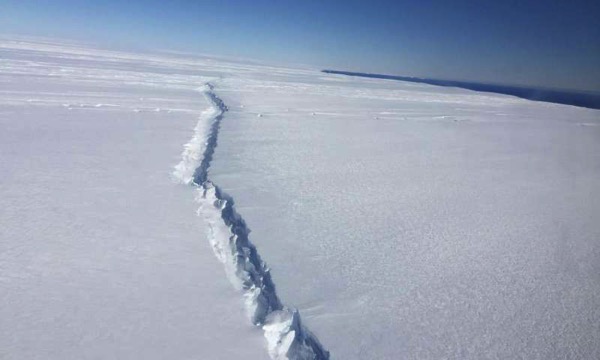West Antarctic ice shelf breaking up from the inside out

A key glacier in Antarctica is breaking apart from the inside out, suggesting that the ocean is weakening ice on the edges of the continent.
The Pine Island Glacier, part of the ice shelf that bounds the West Antarctic Ice Sheet, is one of two glaciers that researchers believe are most likely to undergo rapid retreat, bringing more ice from the interior of the ice sheet to the ocean, where its melting would flood coastlines around the world.
A nearly 225-square-mile iceberg broke off from the glacier in 2015, but it wasn't until Ohio State University researchers were testing some new image-processing software that they noticed something strange in satellite images taken before the event.
In the images, they saw evidence that a rift formed at the very base of the ice shelf nearly 20 miles inland in 2013. The rift propagated upward over two years, until it broke through the ice surface and set the iceberg adrift over 12 days in late July and early August 2015. They report their discovery in the journal Geophysical Research Letters.
"It's generally accepted that it's no longer a question of whether the West Antarctic Ice Sheet will melt, it's a question of when," said study leader Ian Howat, associate professor of earth sciences at Ohio State. "This kind of rifting behaviour provides another mechanism for rapid retreat of these glaciers, adding to the probability that we may see significant collapse of West Antarctica in our lifetimes."
While this is the first time researchers have witnessed a deep subsurface rift opening within Antarctic ice, they have seen similar breakups in the Greenland Ice Sheet—in spots where ocean water has seeped inland along the bedrock and begun to melt the ice from underneath.
Howat said the satellite images provide the first strong evidence that these large Antarctic ice shelves respond to changes at their ocean edge in a similar way as observed in Greenland.
"Rifts usually form at the margins of an ice shelf, where the ice is thin and subject to shearing that rips it apart," he explained. "However, this latest event in the Pine Island Glacier was due to a rift that originated from the centre of the ice shelf and propagated out to the margins. This implies that something weakened the center of the ice shelf, with the most likely explanation being a crevasse melted out at the bedrock level by a warming ocean."
The origin of the rift in the Pine Island Glacier would have gone unseen, too, except that the Landsat 8 images Howat and his team were analyzing happened to be taken when the sun was low in the sky. Long shadows cast across the ice drew the team's attention to the valley that had formed there.
More than half of the world's fresh water is frozen in Antarctica. The Pine Island Glacier and its nearby twin, the Thwaites Glacier, sit at the outer edge of one of the most active ice streams on the continent. Like corks in a bottle, they block the ice flow and keep nearly 10 percent of the West Antarctic Ice Sheet from draining into the sea.
Studies have suggested that the West Antarctic Ice Sheet is particularly unstable, and could collapse within the next 100 years. The collapse would lead to a sea-level rise of nearly 10 feet, which would engulf major U.S. cities such as New York and Miami and displace 150 million people living on coasts worldwide.
No comments:
Post a Comment